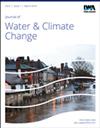Impacts of different El Niño events in the decaying summer on the oceanic source of summer rainfall for eastern China: A perspective from stable isotope
IF 2.7
4区 环境科学与生态学
Q2 WATER RESOURCES
引用次数: 0
Abstract
Extreme precipitation in eastern China (EC) is closely related to the diversity of the decaying phases of El Niño (warm-pool El Niño, i.e., WP El Niño and cold-tongue El Niño, i.e., CT El Niño), but little attention is paid to how the El Niño event variability influences precipitation sources for EC from an isotopic perspective. Stable isotopes are ideal physical tracers that can distinguish different sources of precipitation and quantify their relative contributions to precipitation. Accordingly, this study investigates spatiotemporal variations of water vapor flux and oceanic fraction to precipitation during different ENSO events by an isotopic mixing model. The results show that spatiotemporal patterns of moisture divergence for the decaying phase of WP El Niño are different from that of CT El Niño. The oceanic fraction anomalies present similar spatiotemporal trends with advection fraction anomalies. The spatiotemporal variations of precipitation source anomalies for different El Niño events are closely related to atmospheric circulations, i.e., the intensity and location of the western Pacific subtropical high (WPSH). These findings provide isotopic insights into the precipitation sources by El Niño events in EC. Future studies may further focus on the mechanisms producing extreme precipitation between the two kinds of El Niño.衰减夏季不同厄尔尼诺事件对中国东部夏季降水海洋源的影响:稳定同位素的视角
中国东部的极端降水与厄尔尼诺衰减阶段(暖池厄尔尼诺,即WP厄尔尼诺和冷舌厄尔尼诺,即CT厄尔尼诺)的多样性密切相关,但很少有人从同位素的角度关注厄尔尼诺事件的变化如何影响中国东部的降水来源。稳定同位素是理想的物理示踪剂,可以区分不同的降水来源,并量化它们对降水的相对贡献。因此,本研究通过同位素混合模式研究了不同厄尔尼诺/南方涛动事件期间降水中水汽通量和海洋部分的时空变化。结果表明,WP 厄尔尼诺衰减阶段的水汽时空分异模式与 CT 厄尔尼诺不同。海洋分量异常与平流分量异常呈现类似的时空趋势。不同厄尔尼诺事件降水源异常的时空变化与大气环流,即西太平洋副热带高压的强度和位置密切相关。这些发现为了解厄尔尼诺事件在欧共体的降水来源提供了同位素信息。未来的研究可能会进一步关注两种厄尔尼诺现象之间产生极端降水的机制。
本文章由计算机程序翻译,如有差异,请以英文原文为准。
求助全文
约1分钟内获得全文
求助全文
来源期刊

Journal of Water and Climate Change
WATER RESOURCES-
CiteScore
4.80
自引率
10.70%
发文量
168
审稿时长
>12 weeks
期刊介绍:
Journal of Water and Climate Change publishes refereed research and practitioner papers on all aspects of water science, technology, management and innovation in response to climate change, with emphasis on reduction of energy usage.
 求助内容:
求助内容: 应助结果提醒方式:
应助结果提醒方式:


